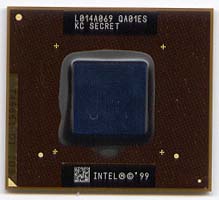Intel's NetBurst Architecture - The Pentium 4's innards get a name
by Anand Lal Shimpi on August 20, 2000 9:39 PM EST- Posted in
- CPUs
The Pentium 4's Chipset & Bus
The move to a 133MHz FSB helped the Pentium III remain competitive with the Athlon, as we've seen from the benchmarks, but in order to handle future applications, there is a definite need for a larger amount of system bandwidth. This necessity is accomplished by the quad-pumped bus that will be the backbone for the Pentium 4's transactions.
The 100MHz FSB is quad-pumped, meaning it yields transfer rates equivalent to that of a 400MHz FSB clock (3.2GB/s). This will give Intel, for the first time since the release of the Athlon and its 200MHz EV6 bus, the advantage over AMD in terms of available system bandwidth. Also remember that although AMD's EV6 bus is easily scalable to 400MHz as well, they haven't seen a need for that boost as of now.
As we mentioned last time, the Pentium 4 will run on Intel's upcoming Tehama chipset, which has since been dubbed the i850. The i850 won't offer any significant enhancements to Intel's Hub Architecture, it will pretty much be a single processor version of the i840 chipset with support for the Pentium 4's bus.

Intel's i850 Memory Controller Hub
Because it has its roots in the i840 chipset, the i850 will feature a dual channel RDRAM memory setup. Unfortunately, RDRAM prices are still not on par with SDRAM prices; combine that with the fact that you will have to install RDRAM RIMMs in pairs on i850 boards (because of the dual channel RDRAM setup) and you are talking about a noticeable price increase simply because of the fact that the i850 chipset only supports RDRAM. Since the MTH is, thankfully, gone, there won't be any SDRAM solutions for the Pentium 4 from Intel until the second half of 2001. This could very well hurt Pentium 4 sales, at least in terms of the hardware enthusiast community's willingness to adopt a processor whose only available platform is an RDRAM only solution. If RDRAM prices don't fall even more, it would definitely be in Intel's best interest to explore the possibility of releasing their SDRAM based P4 chipset earlier than the second half of next year.
While there has been a lot of talk about VIA producing a Pentium 4 chipset, they currently do not have a license to do so. We'll have to wait and see if they can produce a SDRAM based solution for the Pentium 4 before Intel's own chipset.

AMD took advantage of the fact that Intel's flagship platform was and still is the i820. If the acceptance of RDRAM continues to be as low as it has been, the i850 may be a tragic flaw of the Pentium 4, at least for the first few months of its existence.










1 Comments
View All Comments
soldja boi - Thursday, September 3, 2020 - link
really helpfull thank YOU (soldja boi)